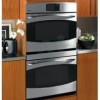GE PT960SMSS Owners Manual - Page 8
Using the oven
 |
View all GE PT960SMSS manuals
Add to My Manuals
Save this manual to your list of manuals |
Page 8 highlights
Consumer Support Troubleshooting Tips Care and Cleaning Operating Instructions Safety Instructions 250 Using the oven. Aluminum Foil Do not use aluminum foil on the bottom of the oven. Never entirely cover a rack with aluminum foil. This will disturb the heat circulation and result in poor baking. A smaller sheet of foil may be used to catch a spillover by placing it on a lower rack several inches below the food. Pan Placement For even cooking and proper browning, there must be enough room for air circulation in the oven. Baking results will be better if baking pans are centered as much as possible rather than being placed to the front or to the back of the oven. Pans should not touch each other or the walls of the oven. Allow 1″ to 11⁄2″ space between pans as well as between pans and oven walls. NOTE: For convection baking of cookies, see the Multi-Rack Convection Baking section. Baking Pan/Sheets Use the proper baking pan. The type of finish on the pan determines the amount of browning that will occur. • Shiny, bright and smooth pans reflect heat, resulting in a lighter, more delicate browning. Cakes and cookies require this type of pan or sheet. • Dark, rough or dull pans absorb heat resulting in a browner, crisper crust. Use this type for pies. • Glass baking dishes also absorb heat. When baking in glass baking dishes, the temperature may need to be reduced by 25°F. Preheating Allow the oven to preheat before placing food in the oven. Preheating is necessary for good results when baking cakes, cookies, pastry and breads. To preheat, set the oven at the correct temperature. The convection fan will turn on during preheating. The control will signal when the oven is preheated-this will take approximately 10 minutes. The screen will show the set temperature. When the control signals, foods should be placed in the oven. Oven Airflow An internal cooling fan operates during all Do not allow this airflow to be obstructed oven modes. The warm air from inside the by blocking the vents at the bottom of the O∞ WARM 450 400 300 350 CLSEEALNF BROIL BAKE OFF PROOF CBOAKNEV. CROONAVS.T CBORNOVIL. oven will be exhausted out through vents door, or at the top of the door by draping located at the bottom of the oven door. kitchen towels over the front of the oven Intake air will be pulled into the oven in undercounter applications. through vents located between the door and the control panel. 200 500 8















